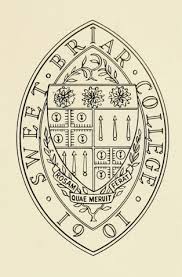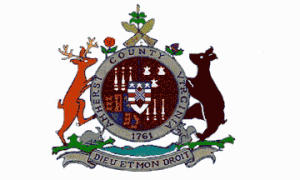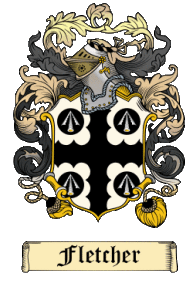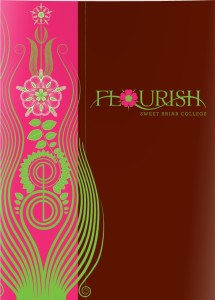
I was recently looking for images of Sweet Briar roses and came across the history of the Sweet Briar seal. History often has lessons to share. In this case, history may be worth revisiting….
There has been quite an effort for the College to question the standing of the Amherst County Attorney and to treat itself as an island untethered to the local community or its stakeholders.
The seal tells an important — and different — story. It seems the College and the County were once important enough that the designer of the seal gave the County the place of highest honor.
The seal was originally designed by Dr. John M. McBryde, the head of the English Department, in 1905. As an English major, I found this fact comforting. The Sweet Briar College museum displays one of the first needlepoint renderings of the crest and describes the history of the seal,
The College crest was designed by John M. McBryde, Jr., in 1905. He was a professor of English here 1906-1909 and was the son of one of the College‟s first trustees and president, John M. McBryde, Sr. At the time that he was recruited for the Sweet Briar board, McBryde senior was president of Virginia
Agricultural and Mechanical College and Polytechnic Institute—today‟s Virginia Tech. He and his son had recently designed VPI‟s crest and seal. When the Sweet Briar trustees asked McBryde senior to design its crest and seal, he deferred to his son the English professor.* McBryde‟s scheme features elements of Lord Jeffery Amherst‟s crest, to acknowledge the school‟s connection to Amherst County; arrows for Elijah
Fletcher, founder Indiana Fletcher Williams‟s schoolteacher father; Tudor roses appropriate to heraldry and suggestive of the Sweet Briar rose from which the property took its name; and the College motto, “Rosam quae meruit ferat.”
In heraldry, it is customary when two families marry one another to divide the shield in half or quartering. When quartered, the most important family appears on the right.
Below the three tudor roses, the coat of arms of the Fletcher family and the arms of Lord Amherst are quartered.

The arms of Lord Amherst are three tilting spears, gold with silver tops on a red field. When Dr. McByrd designed the crest, the use of the Amherst crest was deliberate to emphasize the connection to Amherst County.
Sweet Briar College’s land sits in Amherst County and there are generations of families who lived on campus and attended the College. The Mayor of Amherst filed an amicus brief in support of the County Attorney’s standing in the case against Sweet Briar College. He spells out numerous financial holdings and relationships. Given the history and current reality, it seems fitting that the Amherst seal would be in the place of prominence.
The Fletcher arms, which used to hang in Sweet Briar House, were a silver cross on a black field with four bezants each charged with an arrow.
In the Sweet Briar crest, the Fletcher family is represented by the cross from its family crest. The importance of the family is remembered and significant, but not as significant as the role of Amherst, represented by the arrows, in the upper right of the seal.

Before we leave an examination of the family crest symbols on the seal, I would like to give credit to one of my readers “Geneology Girl” who pointed out that Coat of Arms were originally granted in England and are technically only for the person to whom they were granted. She has a point there, of course. In the case of families using their ancestor’s crests, it stems from both pride and a sense of honoring history. That is the spirit in which I am sure the Sweet Briar seal is intended.
As referenced from a 1938 publication, the rose is positioned three across. On the seal, a tudor rose is used.

Three roses stretch across the top of the Sweet Briar seal representing the motto, “She who has earned the rose may bear it.” The motto stems from Lord Nelson’s motto, ” Parmour qui meruit fert” (Let he who is merited take the palm). The rose symbol and the motto is used to describe the academic environment of Sweet Briar and the beauty of the campus. This rose is also used as the Fletcher family planted many Sweet Briar roses across its plantation.
One of my readers, Richard McClintock, a Latin Professor (so we will trust him!) of Chapel Hill, writes, “Sweet Briar’s motto actually says “Let the one [her, although that is not specified] who has earned the rose bear it,” not “she may bear it.” And Lord Nelson’s motto is “Palmam qui meruit ferat.” – “Let the one who has earned the palm [of victory] bear it.” Some old French (for “lover”!) seems to have slipped into the transcription above.” He also added, “All of you seem to be earning roses right and left nowadays. Keep it up until you may carry palms, too.”

The Tudor roses symbolize Sweet Briar, though not the color of the Sweet Briar rose. Pink is not thought to be a proper heraldic color. The roses on the shield are red in a field of gold.

As a background to the shield is a rise vine supported by the College motto. The colors of the vine, green, gold and brown reflect the early colors used in College marketing materials.
In recent years, the crest and the motto faded to embrace a new brand and image depicted in marketing materials of all kinds. Replacing the crest and more subtle colors is bright pink and green and the emphasis on a pink Sweet Briar rose.



If Sweet Briar is fortunate to live into its future, I would advocate for a return to the traditional crest and motto. The symbols expressing the ties to Amherst County, honoring the Fletcher family, the dignified colors and the seriousness of the motto are worth revitalizing.
History is worth repeating….

Stacey Sickels Locke, CFRE, is a proud graduate of Sweet Briar College, Class of 1988. She served as an employee of the College in the early 1990s working on the $25 million Campaign. During that time, she solicited many leadership gifts which make up the current endowment and she feels a sense of duty that those donations are not used for the closure of the College or for any other purposes than the donors intended. Since then, she has spent her career building support for higher education and the nonprofit community as a staff member and consultant for boards. As a volunteer, she has served Sweet Briar since graduation as a fundraiser, admissions ambassador and now advocate for the #saveSweetBriar movement. She is a member of the Association of Fundraising Professionals (AFP), is affiliated (through the University of Maryland) with the Council for Advancement and Support of Education (CASE) and holds a Certified Fund Raising Executive (CFRE) certification from CFRE International.

Sources
Chad Krouse blog on Sweet Briar Seal
Share this....
